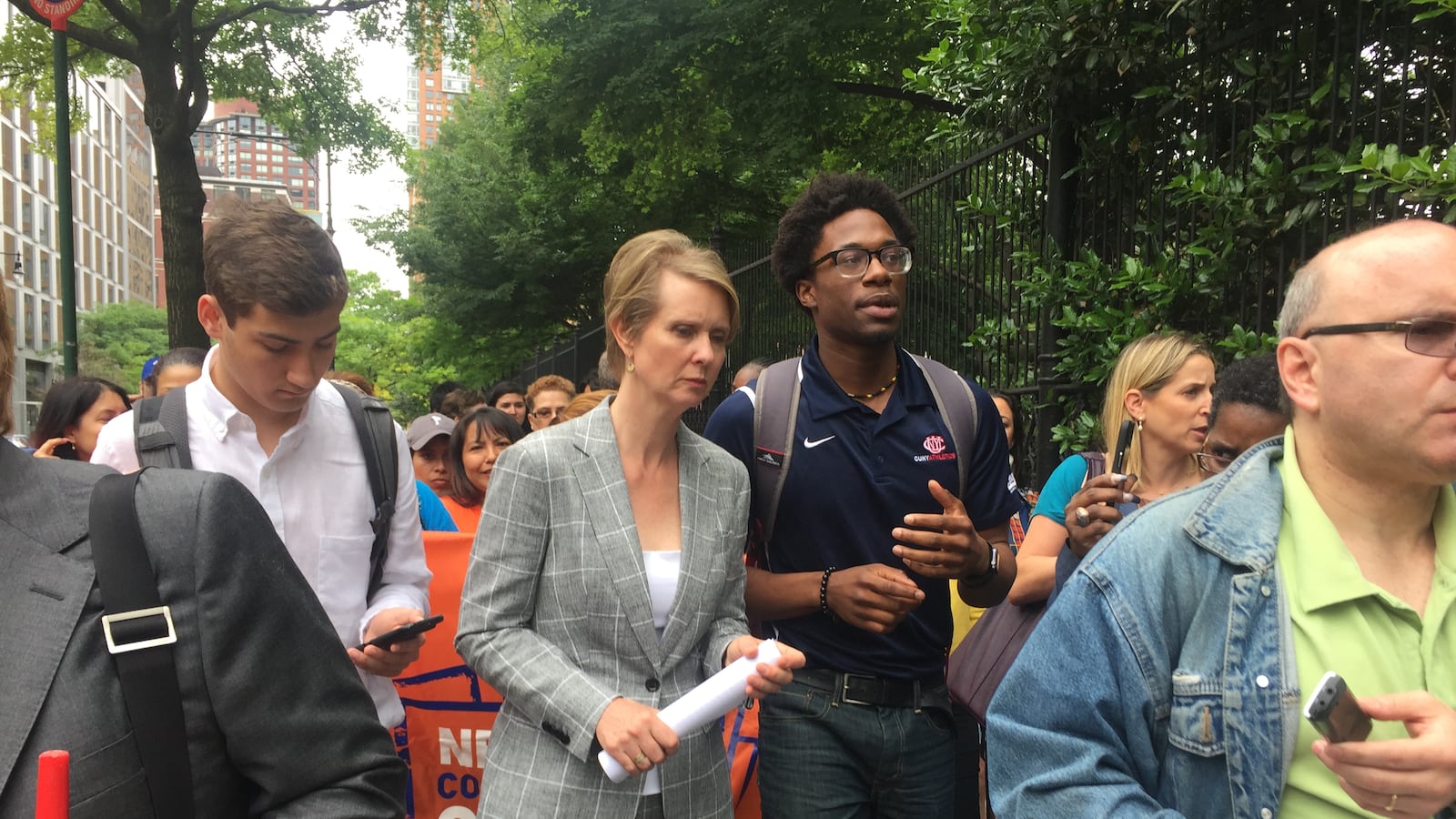Gubernatorial candidate Cynthia Nixon outlined her education agenda on Wednesday, promising to tackle what she called the “unholy trinity” of racial segregation, underfunding, and over-policing in schools.
The plan’s central element is billions in extra cash, which Nixon would funnel into schools to reduce class size and hire more counselors and teachers. Many elements of the plan explicitly tackle race, including pushing districts to reduce suspensions for black and Hispanic students, attract a more diverse teaching workforce, and create curriculum that explores the history of students of color.
“We have two different education systems in our state – one that sends wealthy white children to college, and another that sends poor children of color to prison,” Nixon said.
Many elements of the plan — like sending more money to needy schools and reducing the emphasis on standardized testing — continue recent trends in state policy.
But the plan is likely to face a number of obstacles. The price tag will make it a hard sell, particularly in a state that already spends more on education per student than any other state in the country. And Nixon, who left without taking questions from reporters, has yet to explain how she plans to handle other contentious issues like charter school policy or widespread school segregation.
Here’s what you should know about Nixon’s plan for New York’s K-12 schools.
School funding: A massive boost
Nixon has spent 17 years protesting to push more state money into schools. So it’s not surprising that a massive school funding boost is the bedrock of her agenda.
Nixon wants to increase education spending by $4.2 billion over three years, money that advocates say schools are owed based on the terms of a 2006 settlement. She also wants to invest $200 million annually statewide on 500 new community schools, which add non-academic services such as vision and mental health care.
The tough part, of course, is paying for it. Nixon’s plan relies on tax hikes on the wealthiest New Yorkers and on corporations.
She did not shy away from the hefty price tag on Wednesday, insisting that it is necessary to have an expensive plan. “You know what?” she said. “It is and it should be.”
Officials from Gov. Andrew Cuomo’s office point out that he has increased education spending by 36 percent since 2012, and say there is no legal mandate to spend billions more on schools in the state.
“Cynthia Nixon has been wrong on the facts on every issue she discusses. The difference between advocacy and government is the difference between fiction and non-fiction,” said Cuomo spokeswoman Dani Lever.
School discipline: Replace metal detectors with counselors
Nixon’s motto for the education package was “schools not jails.”
The gubernatorial candidate says schools are over-policed, with too many students of color being suspended or arrested. Nixon said she would trade metal detectors and tough discipline policies for social workers and school counselors.
Specifically, she would require school districts with high suspension rates to undergo “school climate assessments” and ban suspensions for students from pre-kindergarten to third grade.
Those changes would require navigating tricky territory. While some agree that schools are over-policed, others say some suspensions and metal detectors keep schools safe and running smoothly. While the city has moved to reduce suspensions, it’s prompted pushback from others arguing the changes have made schools more unruly. Additionally, a plan to block suspensions for young students was met with resistance from the city’s teachers union.
Inside schools: More diverse teachers and curriculum
In New York City, more than 80 percent of students are black, Hispanic, or Asian, while only 39 percent of teachers are, according to a recent analysis. Nixon says she wants to tackle this teacher diversity gap across the state by investing $6 million annually in the Teacher Opportunity Corps, a state program designed to recruit and train more teachers of color.
Additionally, Nixon said she wants to invest in creating curriculum that pays more attention to the culture and history of students of color. She would spend $20 million in such “Culturally Responsive Education” efforts, which would include outreach to parents and training for teachers.
Testing: Less of it
New York’s math and English tests have become a political lightning rod, as nearly one in five families have boycotted the tests to protest a suite of education changes they felt focused too heavily on the exams.
The state has tried to address some of these concerns. Officials reduced the number of testing days and temporarily paused the use of grades 3-8 math and English tests in teacher evaluations.
Nixon suggested an even more aggressive rollback of the use of standardized tests. She wants the state to “significantly reduce” the amount of testing and “eliminate” serious consequences from being levied based on the tests. She expressed support for the ability to opt out of the exams and is calling for a total repeal of the state’s current teacher evaluation law. (That’s a more substantial change than what the state teachers union is pushing for.)
What she didn’t say
In the 24-page document, Nixon does not take a stance on charter schools, though the state is responsible for deciding how many new charter schools can open and for funding the schools.
A Nixon spokesperson said charter schools were intentionally left out of the plan to avoid distracting from the candidate’s plan for district schools, and that Nixon will share her thoughts on charters in the near future.
Also, though Nixon repeatedly mentioned segregation in her speech, she has only one element in her plan designed to diversify schools — supporting the mayor’s plan to diversify eight specialized high schools. She does not appear to have a more comprehensive plan to integrate schools in New York.

